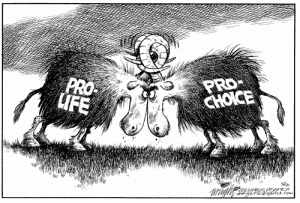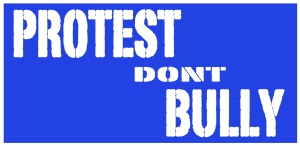In the United States, three U.S. states have passed “buffer zone” legislation, which can create either a “fixed” area around a medical facility or a “floating” area around patients and staff, below is a list of them and how they came about.
Colorado: 100 feet fixed and eight feet floating. After being enacted in 1993, the “floating” provision was first challenged in 1995, when three pro-life activists suggested that it violated their right to freedom of speech. Although upheld in a trial court and by the state’s appeals court, the Supreme Court of Colorado would not hear the case, so the petitioners took their case against Colorado’s floating buffer law to the Supreme Court of the United States. In February 1997, considering its ruling against a floating buffer zone in the case Schenck v. Pro-Choice Network of Western New York, the Supreme Court requested that the appeals court of Colorado re-examine their state’s law. It was upheld again, and in February 1999, the Supreme Court of Colorado agreed with the holdings of the lower court. In the 2000 case Hill v. Colorado, the “floating” provision was again appealed before the federal Supreme Court, where it was upheld 6-3.
Massachusetts: 35 feet fixed buffer zone enacted in 2007. Massachusetts Attorney General Martha Coakley’s Office defended the constitutionality of the statute in the federal court proceedings. In May 2007, Attorney General Coakley testified before the Legislature in support of the passage of the legislation. The buffer zone law was signed by Governor Deval Patrick and took effect on November 13, 2007. Attorney General Coakley successfully defended the statute before the U.S. Court of Appeals for the First Circuit, which affirmed the constitutionality of the Commonwealth’s buffer zone law on July 8, 2009. The 2007 law changed the 2000 law, which provided for an 18 feet fixed buffer zone and six feet floating buffer zone. Enacted on November 10, 2000, this law was struck down by U.S. district judge Edward Harrington soon afterward because he felt there was an unacceptable discrepancy in the floating buffer zone being applied to pro-life protesters but exempted from clinic workers. The law was restored in August 2001 by a federal appeals court.
Montana: 36 feet (11 m) fixed buffer zone and eight feet floating buffer zone.
Several local governments in the United State have, at some time, also passed similar municipal ordinances:
Buffalo and Rochester, New York: 15 feet fixed and 15 feet (4.6 m) floating around four clinics in two cities. The buffer zone resulted from an injunction issued by the U.S. district court in response to a federal lawsuit filed against 50 individuals and three pro-life organizations, including Operation Rescue, by three doctors and four clinics. The law was challenged in the 1997 case court case, Schenck v. Pro-Choice Network of Western New York, by pro-life activist Paul Schenck. The case came before the Supreme Court, where Justices, in considering Madsen v. Women’s Health Center, ruled 8-1 to uphold the constitutionality of the fixed buffer zone, but not that of a floating buffer zone.
Melbourne, Florida: 36 feet fixed buffer zone around a clinic, 300 feet (91 m) floating buffer zone around patients, and 300 feet (91 m) buffer zone around the homes of the clinic’s employees. The injunction also regulated noise levels outside of the clinic and prevented demonstrators from displaying images which could be seen from inside. It was upheld in full by the Supreme Court of Florida but came before the federal Supreme Court in Madsen v. Women’s Health Center in 1994. The Court upheld the fixed buffer zone, and the noise regulation around clinics and in residential areas, but rejected the floating buffer zone, residential buffer zone, and prohibition against displaying images.
Pittsburgh, Pennsylvania: 15 feet fixed buffer zone and eight feet floating buffer zone. The statute was approved by the Pittsburgh City Council in December 2005. In 2009 a three judge appeals court panel found in Brown v. Pittsburgh that while either a fixed buffer or a floating buffer alone is constitutional, this combination of buffers is “insufficiently narrowly tailored,” and thus unconstitutional.
Vallejo, California: fixed buffer zone which requires protesters to remain across the street from a clinic enacted in 1991. After the Supreme Court of California upheld the injunction, the case was taken to the federal Supreme Court in October 1994, but was remanded to the state court due to the recent Madsen v. Women’s Health Center decision. The California Supreme Court again upheld the buffer zone in July 1995. On March 17, 1997 the case reached the federal Supreme Court as Williams v. Planned Parenthood Shasta-Diablo, and Justices voted 6-3 to decline the case.
West Palm Beach, Florida: 20 feet buffer zone and noise ordinance approved in September 2005. U.S. District Judge Donald Middlebrooks found the law to be an infringement of the right to free speech on April 11, 2006, and ordered that it be enjoined, but upheld the regulation against excessive noise.
Chicago, Illinois: 8 foot floating buffer zone within 50 feet of clinic entrance enacted in November 2009.
Source: Wikipedia – Legal protection of access to abortion, en.wikipedia.org/wiki/Legal_protection_of_access_to_abortion




